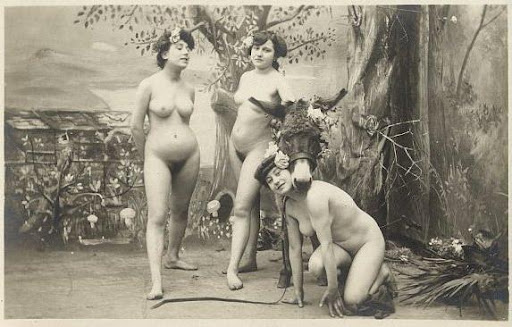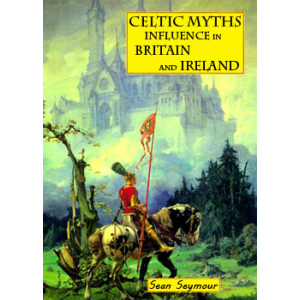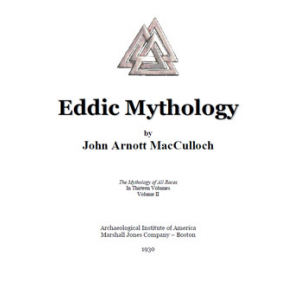Greetings and Gnosis from our Lord the Donkey!
I have a long story to share with you
So welcome and be at ease
Sit your ass right down
Relax into this long-eared tale
A yarn that spins out from a very long time ago
Let yourself drift back
Back into the ancient past
Into the land of Egypt
The home of the Mysteries
The birthplace of the gods
A ka dua
tuf ur biu
bi a'a chefu
dudu nur af an nuteru
Plutarch gives us his assurance
That the god Set or Seth, the muderer of Osiris
Was known to take the form of an ass
Set was a god of wildernesses and remote places
A strong god who ruled over deserts and wastes
Where the senses and determination of a donkey
could be crucial for survival
Donkeys were valued for their endurance
And for their careful, steady gait
An ass was a choice mount for an ornamented noble
Or for a pregnant woman or one with a babe in arms
Because the animal was so prudent and deliberate
That it would hardly ever make a misstep
Or take a spill
The priapic qualities of the donkey
Were also important to the worship of Set
The patent virility of the jack
All male asses are called jack
A familiar form of "John"
The patent virility of the jack
Was an emblem of powers that inspire
And powers that sustain against adversity
The cult of Set flourished
In early dynastic times
Well through the twelfth dynasty of old Egypt
But things changed in later centuries
Set became associated with the Hyksos people
Conquerors from Syria
Who occupied Lower Egypt
The Hyksos identified Set
With their god Baal
Since both were lordly, beastly, priapic gods
And Set was also a god of remote places
Distant lands, like the home of the Hyksos
After the Egyptians overthrew their Hysksos rulers
They reviled and demonized Set
Because of that association
The prudence and virility of the donkey
Was re-interpreted as stupidity and sensuality
From being a god of the wilderness
And of the hidden power of nature
Set was reduced to a figure
Of physical and moral evil
Set was made into a satan
A foe of Egypt and her gods
The true votaries of Set
Were forced to propagate his worship in secret
Excluded from the communion of official cults
The ass went underground
But he did not die
Like that of the later Roman Empire
The old Egyptian religion was very diverse
It included many and varying gods
There are few instances of the sort of rejection
That was visited upon Set
Demoted from god to devil
But one god was even more loathsome
A god who needed not only to be transformed
But to be eradicated entirely
There was a god who tried to devour all of the other gods
A god of light
A god whose truth was final and exclusive
Who would permit no other gods to be held before him
Who designed to leave no other gods after him
Who was apparent everywhere and in everything
But intelligible only to the heart of the king
The king was Amenophis IV
And the god was Aten
In the name of Aten
And by his authority
The king abolished all of the traditional cults
He banned the feasts and festivals
The sacred processions were stopped
The images of the gods were destroyed
From the sea in the north
To Nubia in the south
The names of the gods were effaced
Especially the name of lordly Amun
The king moved the capital to a new city
The king took the new name Akhenaten
A name meaning "Good for Aten"
The new god and his king
Damned the gods of Egypt
And scorned their memory
For one short generation
Egypt suffered under the rays of Aten
An incomprehensible god
A god of pure light and pure being
A god who offered no consolation to the people
But who occupied the king's convictions
In less than twenty years
There was a counter-revolution
Aten was the one whose memory was obliterated
Amun retook his heavenly throne
The gods returned to their stations
Vowing new fealty to Amun
So that no such tragedy should ever recur
But those who had embraced the doctrines of Akhenaten
Could still nurture their consciences in secret
The light went underground
But it did not die
The Atenist episode
Laid bare the spiritual tensions
That had been growing in Egyptian religion
Some Atenist features entered into the cult of Amun
And an overall order was restored
But the rapid changes left a sense of uncertainty
The repressed cult of Set gained new energy
Other dissenters and rebels throughout the kingdom
Began to use religion as a vehicle for their complaints
From this unstable scene
Emerges a legendary figure
A saint of the Gnostic Catholic Church
We know him as Moses
From the Hebrew histories of Moishe
And Mose is a good Egyptian name
Or at least part of one
We find it even in the names of kings
Like Tahutmose, meaning "Child of Tahuti"
Of whom is Moses the child?
Our hero is a savvy Egyptian prince
His family has worshipped Set for long centuries
In the margins of Egyptian nobility
And now their time has come
He connives with the authorities
To be given recognition and full authority
Over the religious dissidents
And an assortment of outcastes
To lead them into a "land of milk and honey"
Where Egypt will be rid of them
And Sutmose will rule them as king
So these people governed by Sutmose
Were the original Hebrews
Worshippers of the great donkey god
Whose true name Set was ritually supressed
From the long habits of repression in Egypt
Instead, this god of the ancestors of Moses
Became known by the old Egyptian word for donkey
An onomatopoeic braying
IA-hOh!
Even that new name IAhOh was never spoken
Where the persecuting profane might hear it
And eventually it became a soundless word
An entity confined to the literate page
Spelled in Hebrew: "Yod Heh Vav Heh"
The most common spoken title for the Hebrew god
Came not from the Set cult
But from others among those emigrants
Led into the wilderness by Sutmose
Kindred spirits in the worship of the forbidden
The sublime ass was called Aten-Ai
"Praise Aten"
Ateh Gibor le-Olahm Adonai!
Thou art mighty unto the ages
O jack of the heavens
Light that shines in darkness!
And Plutarch further instructs us
That Typho escaped out of the battle upon an Ass
After a flight of seven days
And that, after he had got into a place of security
He begat two sons, Heirosolymus and Judaeus.
And Plutarch himself insists that this story
Is only a fabulous version
Of the actual Exodus of the Hebrews
Properly associated with Set and the ass
Now the heirs of Sutmose and his crew
Were a fierce and treacherous people
They fought for land
And they conquered tribes and cities
As they settled in to rule
They found that they had sympathy
For the gods of Canaan
And the other peoples they had defeated
Whether or not they knew that their own god
Their sacred ass
Was a close cousin of Baal
Whether or not they consciously missed
The pleasures of the Egyptian feasts and festivals
They settled in to an increasingly diverse
And fecund set of observances
The divine donkey might be eclipsed by the moon goddess
Or enjoy himself with the holy cow of heaven
Baal too, and other gods and goddesses
Found places in the popular religion
And sometimes in the cults of the rulers
The Hebrew scriptures are full
Of accounts of these trends
And the prophets that denounced them
And the punitive jealousies of IAhOh or Aten-Ai
Those scriptures were written later
By Judaeans in exile
Hebrew aristocrats held captive in Babylon
At the mercy of the Persian Empire
These exiles learned from their captors
About the importance of unified religion
For political and military ambition
They wrote their scriptures to preserve history
But also to present it in a particular way
One that would unite the Hebrew people
One that would create a IAhOh
As intolerant as Aten
They succeeded in their design
And from Zerubabbel to Herod
IAhOh did not lack a sanctuary
But that Atenist approach
Excluding all other objects of worship
And confining the gnosis
The true knowledge of the ass
Among a priestly elite
That Atenist approach
Created stress on the people
And within the Judaean leadership
There were those who longed for the earlier days
When public religion
Meant riotous festivals
Instead of pharisees on streetcorners
So it was that the Hebrew Iohannon
Became Jack the Baptist
Giving the people a part
In the spiritual life of the society
And his successor and cousin Iesous
Who had spent his childhood in Egypt
He rode into Jerusalem on an ass
In a procession of triumph
Like the old Egyptian festivals
The Christian Tertullian records with horror
An anecdote from ancient Carthage
Where an apostate Jew one day appeared
Carrying a figure robed in a toga
With the ears and hoofs of an ass
And bearing a placard that read,
DEUS CHRISTIANORUM ONOCOETES
Which is to say, "the Christian God begotten of an ass"
Tertullian further admits that
"the crowd believed this infamous Jew"
On an old Gnostic gem
We can see the image of an ass-headed person
Instructing two pupils
And robed in the pallium
A distinctive garment of Christian leaders
Even in the pagan Mysteries
Of Greece and Rome
We find the proximity of the donkey
To the essence and vitality of religion
The Metamorphoses of Apuleius
Is a text better known as The Golden Ass
Because its protagonist Lucius
Attains to the mysteries of the Goddess
After being magically transformed into a donkey
With the hermetic stirrings of the Renaissance
The ass appears yet again
Although the vulgar take the donkey
As a symbol of ignorance and stupidity
Occultists and magicians know better
Cornelius Agrippa, in his "Vanity of the Arts and Sciences"
Praises the ass as a paradigm of virtue
Giordano Bruno, whose heliocentrism
Was wedded to his hermetic magick
Made the donkey a symbol
Of the highest mystical state
In his personal cabala
Declaring it to be the Triumphant Beast
Finally, Saint Friedrich Nietzsche
In his magnum opus Thus Spake Zarathustra
Makes the ass the focus of a festival
Created by the higher men
A festival that apes the Christian eucharist
And one that provides an affirmation
Of the strength and beauty and potential
In nature and humanity
If an ass inspires us to create,
"Let us create without fear
For we can create nothing that is not GOD!"
In the name of IAhOh!
Hagios, Hagios, Hagios! IAhOh!
Love is the law, love under will.
Further reading (free e-books):
Max Heindel - The Message Of The StarsAleister Crowley - Liber 052 Manifesto Of The Oto
James Lewis - Remanifestation The Process Explained
Labels: question lathrop witches creed goddess alive speech high linear poetry collection religion other goddess alive hail mary issue 2007 correspondences aleister crowley with enochian magic circle intimation reference constitution










